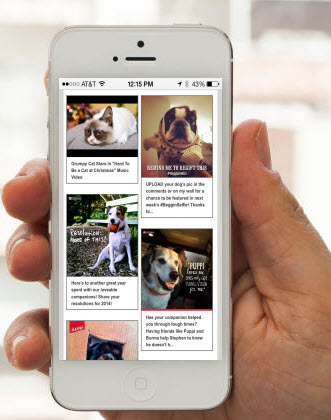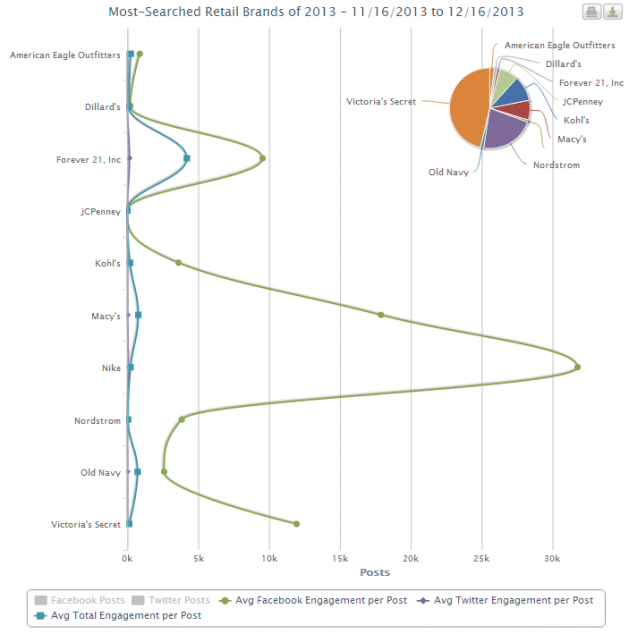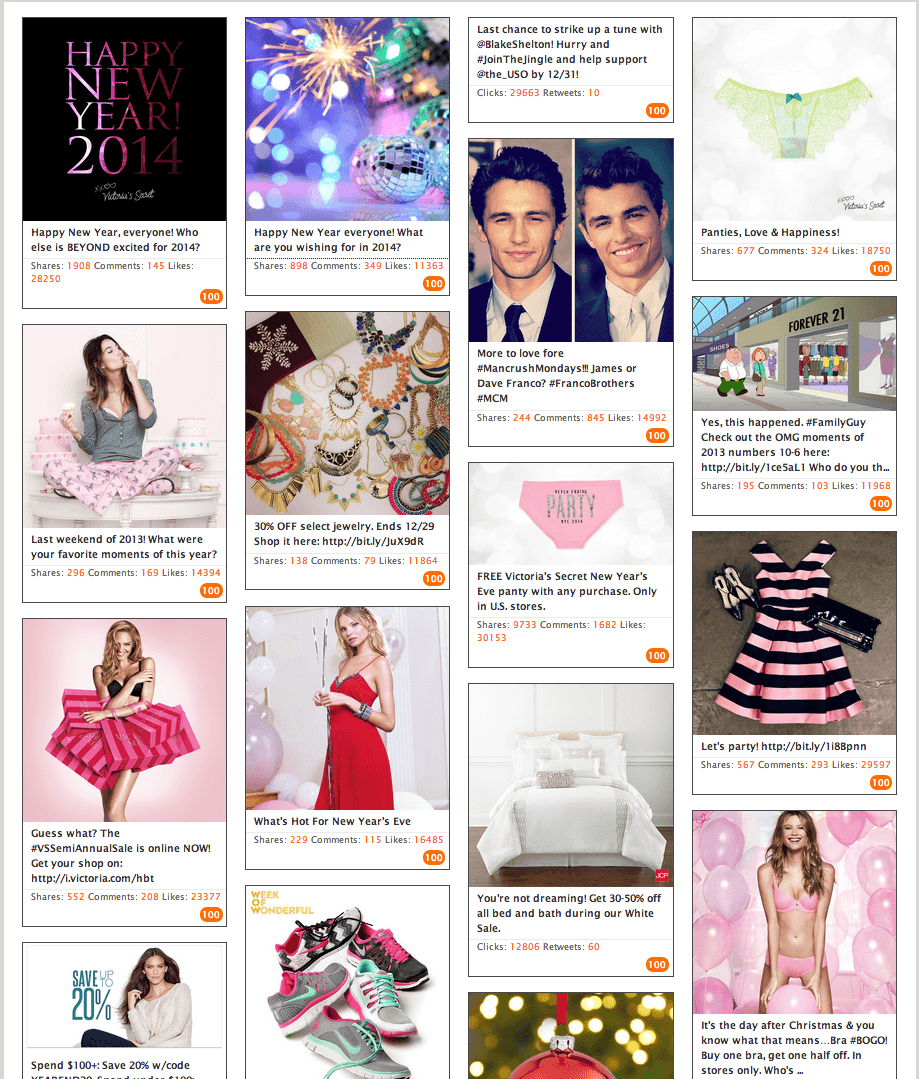Visual content marketing has transformed retailers – in a good way. Here, we are going to address what visual trends are powering the top most-searched retailers of 2013 and what you can learn to drive your own business. With Google’s Hummingbird and other changes de-emphasizing keywords, it is more important than ever to focus on topical authority and social networks to ensure visibility.
As brands shift from “talking at you” to “talking with you”, the use of relevant visual content marketing will define the winners and losers in 2014. Mobile-enabled content marketing and eCommerce has reached epic proportions. Today, it shows 50% of traffic goes to top retailers. This clarifies any uncertainty that retailers like Macy’s and Kohl’s are at the top the list with highly effective mobile strategies.
Data-driven retailers with the ability to meld their paid, owned, and earned media has never been more important with content marketing, mobile, and eCommerce integration acting as one.
Visual Content Marketing
Go bold or go home. If you’re a brand and you’re not doubling down on an image strategy, say beyond social via Content Hubs, now is your chance to enhance your own media amplification. Brands have already started with hashtag content hub sites, displaying what people tweet, and some social hubs are doing simple visual content aggregation.
Choosing tools and systems that provide robust, intelligent content handling will be the deciding factor on which brands retain consumer’s attention. And, more importantly, the consumer “share” button click, bringing the brand along for the ride. There’s no question that retailers are leveraging Tumblr, Pinterest, and Instagram to push visual assets.
 Lindsay Ellingson at the #VSFashionshow . Photo / Creative Commons
Lindsay Ellingson at the #VSFashionshow . Photo / Creative CommonsAsk yourself this question: Is my content going to be more compelling than my friend’s baby picture? You must become a source of great content discovery. This goes beyond good storytelling. We’re talking about sustaining a content relationship and becoming the go to source for all things relevant in your industry.
The brands that are leading have figured out that when a consumer comes to them and they don’t have the answers, they’ll likely end up on a competitor’s site.
Mobile Optimized Content
With some retailers seeing up to 50% traffic from mobile devices this year, it’s a real wake up call for those that have yet to get their mobile mojo in motion. It’s easy to see how much consumer action is on mobile when you monitor the referral traffic from social channels.
As more traffic increases, developing a more user-friendly site for a true mobile experience is critical. The challenge for brands is when to stop. Do you create a mobile site, optimize your current site, or create an app? Native apps work well for all brands. Kohl’s, Macy’s, and Amazon top the list with their mobile deployments. Consider this – is your site truly mobile? Second, did you make a native application just because everyone else did?
Remember you’re competing with your consumer’s Instagram, Twitter, etc apps for attention.
Content Marketing
 The mobile optimized retailer will have a competitive advantage. Example of mobile Content Hub photo / InfiniGraph
The mobile optimized retailer will have a competitive advantage. Example of mobile Content Hub photo / InfiniGraph2013 was a major coming-of-age year for content marketing. For 2014 it is the must-have strategy. Many analyst reports are putting it at the top of their lists and brands are budgeting for more content.
If you are serious about keeping your consumers engaged, the bar has been lifted. The retailers that have figured out the types of content and volume of content their consumers respond to will have the upper hand. Consumers have a limited amount of digital bandwidth which requires your content to have a heavy hand on usefulness. Content Engineering will play a major factor in a brand’s approach to melding their mobile, eCommerce, and content marketing offerings.
Retailers need to focus on what content is performing well around them. The only way to do that is to have access to the data. If retailers offer many brands and they don’t know what’s trending in their own stores then shame on them. This is a massive opportunity to amplify what’s already relevant to your customers and dynamically link it to the purchase point. Brands must go beyond just visual to a more proactive discovery. Discovering what content is most shared and engaged is the catalyst to your next post.
E-commerce and m-commerce – A Big Data play
In 2013 global sales reached and epic 1.25 trillion with 15% of that coming from m-commerce (mobile commerce). This demonstrates consumers’ relentless desire to have it now. Those retailers harnessing their big data assets intelligently will capture a greater market share.
The biggest differentiation comes from brands that are using the massive data coming from all this additional engagement. Recommendation engines, prediction platforms, and smart algorithms separate retailer winners from losers. Combining content and commerce in a seamless fashion means consumers get a more personalized experienced, which will surely increase conversion.
Most Searched Retail Brands 2013
 Most searched retail brands of 2013 Engagement Performance Analysis Photo / InfiniGraph
Most searched retail brands of 2013 Engagement Performance Analysis Photo / InfiniGraphEvery year Google creates their Trend report listing people, places, and things searched for most by users globally. The most searched doesn’t necessarily mean the most engaged. Above is a detailed analysis on the types of content and the overall average engagement of the top 10 retail and apparel brands that were searched most often in 2013. As you can see on the left side of the graph, Nike, Macy’s, Forever 21, and Victoria’s Secret top the list with the most engaged content.
Engagement is how much consumer interaction was obtained on their content posts (comments, shares, likes, retweets and clicks). There are many other engagement parameters to look at but to be consistent we look at the top two most used networks by the retailer, Twitter and Facebook.
The top 10 Google Trends list used many factors to determine what was most searched, however, for some retailers this is not the type of attention they want. We are sure that Target would have topped the list with the recent credit and debit card hacking scandal, but this doesn’t help their bottom line at all. Using content engagement is a solid barometer and the type of content that trends with consumers positively shows who is winning the engagement battle.
- Kohl’s — Kohl’s achieved the top spot this year on Google’s most searched retail and apparel brands. That is with a financial struggle holding the company back the peaks in search happened around Thanksgiving when an Illinois police officers shot a shoplifter. This is the type of PR most brands don’t want.
- JCPenney — Like Kohl’s, JCPenney is experiencing it’s own financial woes. CEO being sacked, the stop-in-shops was a #FAIL, and a branding redesign just created more confusion. Overall, there was lots of interest in what was going on at the company but not the type of engagement to drive sales.
- Nordstrom — On the high-end, Nordstrom’s, like Macy’s, came in strong. By contrast, Nordstrom had a very strong 2013. Consumers responded to their Blue Nile partnership and their crowdsourcing in-store display strategy via Pinterest. Nordstrom leveraged the content hub to their advantage and continues to use strong visuals to engage their customers.
- Forever 21 — Teen retailer Forever 21 is on a roll to not only topping the most searched but also being in the top 5 most engaged. Being a trend spotter and getting their fast fashion to market has been key. The Forever 21 expansion has paid off, which puts greater pressure on brands like Abercrombie & Fitch who have not escaped their own PR nightmares with run of the muck CEO mouths.
- Victoria’s Secret — Can be summed up in one hashtag: #FSFASHIONSHOW. The imagery from the show caused an engagement storm with female and male consumers. Nothing like something sexy to propel your brands and VS does it so well with the images and their social push that any brand should be envious of.
- Old Navy — Old Navy topped the search list during BlackFriday and with a little help from Gap who didn’t make the list. It got some Black Friday, love but couldn’t keep the momentum going.
- Macy’s — Macy’s received lots of love this year starting in October and pushing through Black Friday, rounding out with Macy’s Thanksgiving Day Parade. Big earnings coming in from their integrated retail strategy means they have seen lots of bucks show up this holiday season. Brands attempting to hold a candle to Macy’s, such as Sears, are going to have to alter their content strategy to keep up.
- American Eagle — American Eagle is not flying like an eagle with 68% drop in profits and a lack of original content. Not engaging the consumer and no big story has put more pressure on this once great brand. Competitors like Forever 21 are not letting up, demonstrating that the retailers who engage are winning.
- Nike — Nike has been a long time friend of Google search and has hot products to boot. They have a continuous sports marketing effort not to mention Finish Line, Foot Locker, and Sneaker Freaks pushing their own efforts, helping drive Nike to the top on both most engaged and searched.
- Dillard’s — Dillard’s was not in last place, but for this list they are. There was lots of activity on store closings and relocations but they were at the bottom of engagement along with JCPenney. The good news is they seem to have changed their game, and content and images show it is starting to work.
Actions to take in 2014:
- Retailers need to be smarter about how they leverage their visual content and promote high performance over quantity. The Content Hub will be important due to the owned media nature.
- Brands need to budget not just content creation but VISUAL content creation. Content is key, but without strong images it misses the point of many key social platforms.
- Using themes and events to create quality images and amplify your brand story to build more earned media on your owned assets. Don’t be so dependent on channels you don’t control.
- Mobile optimized content distribution and eCommerce / mCommerce integration must be a central focus with strong emphasis on data capture and strategy to use that data.
- Consolidate your data strategy and become more data-driven in your marketing. The bigger the brand the more data. You must look beyond collection to intelligent prediction to gain and retain an edge.
As brands struggle to stay relevant and enhance consumer loyalty, the gap between the winners and losers will widen. 2014 will truly be an exciting year for the data-driven marketers and how real-time marketing will impact visual content usage. For the brands that have structured a high performance content marketing team and the data needed to adjust their strategy will be a big part of who dominates their industry.
Your turn: What do you see as the key deciding factors that brands must implement to further differentiate and increase consumer engagement?
Featured Image Credit: InfiniGraph




